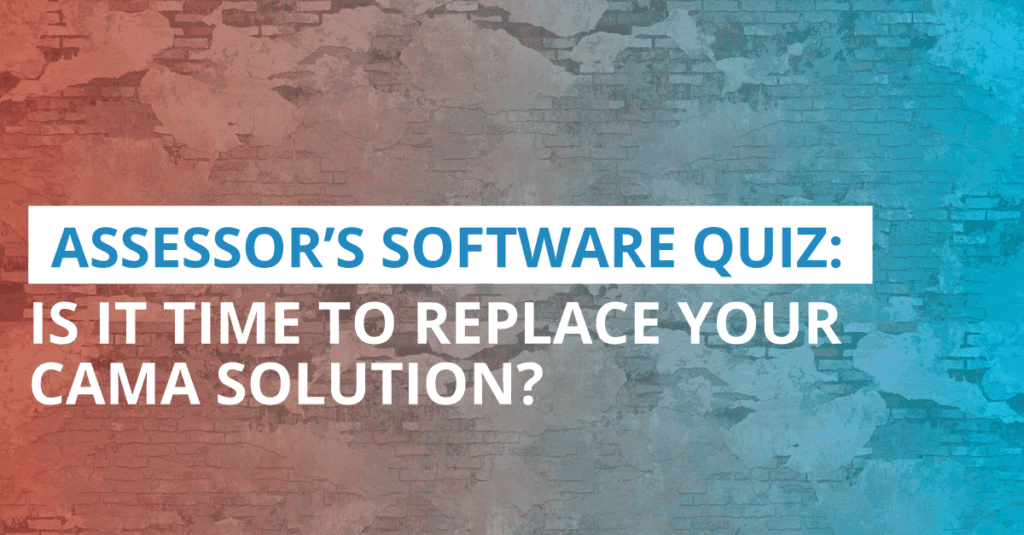Nobody should undertake the transition to a new CAMA software solution lightly. It’s usually preferable to work with your CAMA vendor to improve your existing software, to leverage what you’re currently using, than to opt for what can be a challenging transition to new software. That is, if you can.
But sometimes fixes aren’t enough. You may reach a point when too many things simply aren’t working. A time when your CAMA software is no longer meeting many of your basic needs, let alone providing you the benefits of today’s best-in-class property tax assessment tools. When the limitations of your existing software or vendor relationship ultimately limit your organization’s efficiency and effectiveness.
How do you know when you’re at that point? How can you tell it’s time to seriously consider replacing your CAMA software? You can start by asking — and answering — these five questions.
Question #1: Are you doing significant manual work outside your CAMA software?
Good CAMA software is designed to accommodate your business needs and practices. And the best CAMA software adapts as those needs and practices change over time, by providing updates and using new technologies to ensure your CAMA solution keeps pace with your functional requirements.
Can you still rely on your CAMA solution to handle those requirements — assuming you started with good CAMA software? Or are you keeping notes or spreadsheets outside your CAMA, or using other standalone software applications to accomplish routine tasks?
If you’re doing significant manual work outside your CAMA software, Answer #1 is “Yes.”
Question #2: Are you finding your CAMA software doesn’t work with your intra-departmental systems?
Most property tax assessment offices are responsible for a myriad of functions, including real property, land records, personal property, and appeals. All those functions rely on underlying computer systems. The ability of those systems to share data and streamline communications across functions within your office is critical to being able to get your work done correctly, in a timely manner.
Does your CAMA software work harmoniously with the other systems within your assessor’s office? Or do you have to go outside your CAMA to get information from other people or systems in your department to do your job?
If your CAMA software doesn’t work with your intra-departmental systems, Answer #2 is “Yes.”
Question #3: Are you finding your CAMA software doesn’t work with inter-departmental systems?
County and city governments, too, are responsible for a myriad of functions, with activities like appraisals done in your office, GIS mapping done in another office, deed registration done in a third, building permitting done in a fourth, and so on. And again, these offices typically have their own underlying computer systems. To the extent you need information that originates or resides in one of those systems, routine electronic data sharing is crucial.
Does your CAMA software work harmoniously with other systems within your larger county or city government? Or do you have to go outside your software to get information from other people or systems outside your department and then manually enter that data into your CAMA software to do your job?
If your CAMA software doesn’t work with inter-departmental systems, Answer #3 is “Yes.”
Question #4: Does your CAMA software limit or preclude access to industry-leading appraisal tools?
The industry is awash in appraisal tools that offer massively improved functionality to virtually every aspect of day-to-day property tax assessment work. Take your pick: mobile field appraisal, property sketching, aerial and street-view imagery, industry cost data, multiple regression analysis (MRA), and artificial intelligence (AI), to name just a few. These tools enhance your team’s productivity and lead to better (and fairer) outcomes for those served by your office.
Does your CAMA software offer seamless integration with other vendors’ appraisal products, allowing you to take advantage of best-in-class tools? Or are you limited to whatever version of these functionalities your CAMA vendor provides — if they offer any at all?
If your CAMA software limits or precludes access to industry-leading appraisal tools, Answer #4 is “Yes.”
Question #5: Are you frustrated with your CAMA vendor relationship?
Your CAMA solution is more than just software. It also includes support from your CAMA vendor. That support — and how frictionless it is to ask for and get — is fundamentally tied to the value you derive from your vendor relationship.
Does your CAMA vendor consistently meet your ongoing and changing needs, in a timely manner and on your terms? Or do you frequently find yourself at odds with your vendor, in situations where they perhaps don’t address important business process issues or change requests, or they don’t improve and update your software regularly — or at all?
If you’re frustrated with your CAMA vendor relationship, Answer #5 is “Yes.”
Tallying Up Your Answers
If you answered “Yes” to one or more of the questions above, your organization may not be as well served by your existing CAMA software or vendor as it could (or should) be. That’s a problem. But is it a big enough problem that it’s time to consider replacing your CAMA software?
Possibly. It depends on a variety of factors, including how many times you answered “Yes” to these quiz questions and, perhaps more importantly, the intensity of your answers. It also depends on the degree to which you believe your answers to these questions translate into diminished productivity, efficiency, and effectiveness — and diminished service to the taxpayers of your jurisdiction.
If you’re not sure where your situation stands or what your options might be, reach out to me here. Farragut can guide you through this consequential decision, whether it involves improving or replacing your current CAMA software. We want to help your organization reach its full potential.





